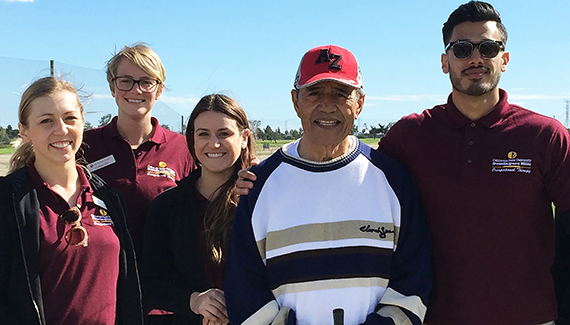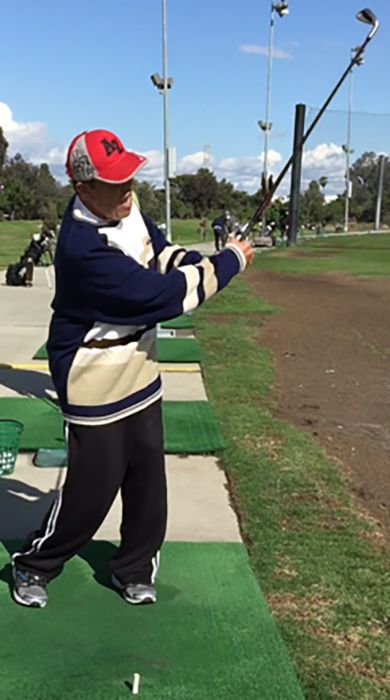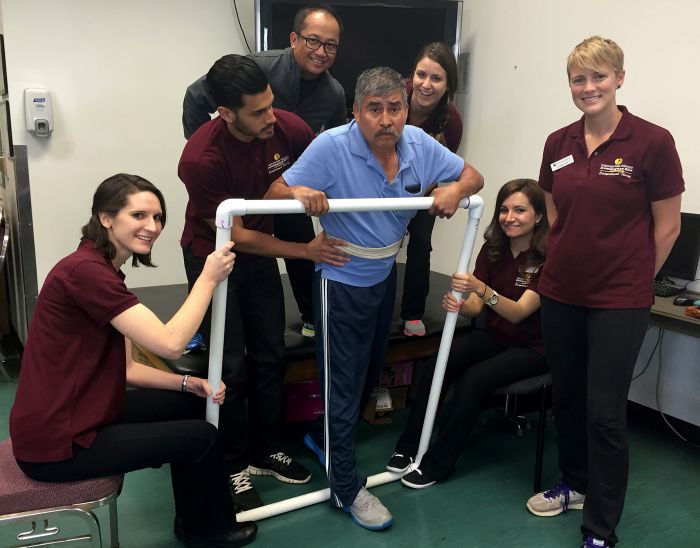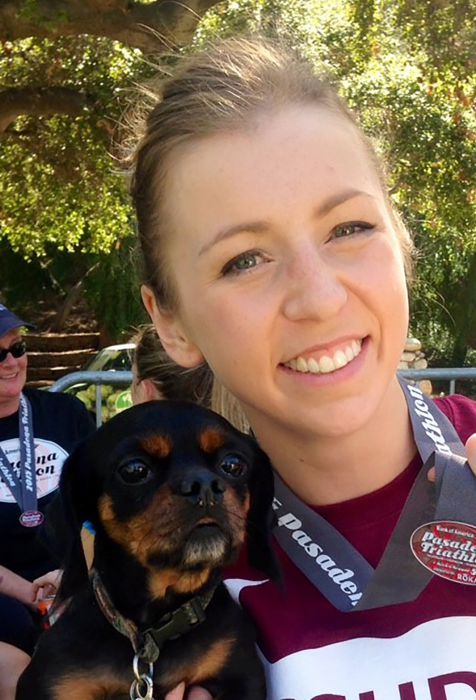
After just four sessions working with Paul Penoliar, an occupational therapy specialist and clinical instructor at California State University, Dominguez Hills (CSUDH), stroke survivor Tiufono Taliulu was able to return to Victoria Golf Course’s driving range to continue his rehabilitation while working on his golf swing.
Taliulu is just one of approximately 200 members at the Joseph B. Jr. and Mary Anne O’Neal Stroke Center, located in the Carson Center, who Penoliar and his student interns provide services for through CSUDH’s Department of Occupational Therapy.

Taliulu, a long-time regular at the golf course, felt “so good” near the end of the session there that he began teaching Penoliar and his students studying in CSUDH’s Master of Science in Occupational Therapy (MSOT) program how to improve their own golf swings.
“Mr. Taliulu had poor motor control and poor overall use of his right arm. We performed specific techniques in the clinic to elicit and access motor control, and we simulated activities designed to mimic a golf stroke,” said Penoliar. “Mr. Taliulu said he thought he would never be able to get back to the course where he learned how to play golf and where his leisure circle of friends play. It was a very emotional event for both him and his spouse, who was also there that day.”
The stroke center works with clients who have experienced stroke and have problems using their arms and legs, have poor balance, and/or are experiencing pain and other issues that affect their overall independence and ability to perform basic activities, such as dressing and grooming.
Penoliar, who lives in Glendale and has been a practicing OT for over 15 years, earned his bachelor’s degree in occupational therapy (OT) at USC and is currently pursuing his clinical doctorate at Creighton University in Omaha, NE. His area of expertise is focused on rehabilitation of adults with neurological impairments–specifically stroke–but he has also worked with clients with a variety of diagnoses, such as traumatic brain injury, spinal cord injury and cardio pulmonary disorders.
Success stories at the stroke center like Taliulu’s have resulted in a waiting list for Penoliar’s services since he and his students first arrived at the clinic in 2014.
“It’s been a short amount of time, but everyone is so excited to work with him [Penoliar]. There’s a huge waiting list,” said Dani Cook, senior services coordinator for the City of Carson who coordinates the therapists working with the mostly lower-income seniors. “When we’re treating five patients every two weeks, it’s a bit of a slow start for them, so people can’t wait to get in and get an appointment with Paul. He’s very personable, and he speaks some Spanish, which is great because many of our members speak Spanish.”
The fully accredited MSOT program has two levels of fieldwork for its students. Level 1 is mostly observation and takes place once a week throughout the semester, and level 2 features full-time, three- to four-month internships at clinical sites. Each MSOT student is required to complete six fieldwork placements: the first four are the didactic portion of the program that consists of working with adolescent, pediatric, adult, and geriatrics populations respectively. The fifth and sixth are at sites such as hospitals, clinics, or at community-based centers.
“The full-time internships requires direct supervision from the OT, unlike level 1 which is only observational with students in their first year and just starting to learn,” said Penoliar. “As a program and department, we internally made it our policy that we don’t send our students to places where there is not an OT because we are very particular about the alignment between theory and practice.”

The MSOT program, which prepares students to work as “OT generalists” after graduation, currently has more than 350 contracts with various types of health care facilities throughout the region where faculty and students conduct research projects, clinical skills training, and internships.
“Our faculty are truly passionate about teaching as well as their clinical practice. There are a lot of sites out there that don’t have OTs, so the need is pretty clear. We consider these sites as opportunities to accomplish the mission of our program and the university by providing service to the community,” said Terry Peralta-Catipon, chair and director of the MSOT program. “By using a service-learning model, we connect our faculty who have specialization in particular areas and establish faculty fieldwork programs that involve our students in providing individual as well as group occupational therapy services to clients.
“A couple of years ago we started with just two sites,” added Peralta-Catipon. “We’d have faculty facilitate community mental health group sessions with individuals who have various diagnoses, such as schizophrenia, anxiety disorder, bi-polar disorder, as well as autism and development delays. Since I’ve been an OT consultant in community mental health for the past nine years, these populations are dear to my heart.”
Along with the community mental health program sites and the stroke center, other program locations include the 27-acre Century Villages at Cabrillo in Long Beach, which helps military veterans, children and others overcome homelessness; Next Step Fitness in Hawthorne, a specialized gym serving those with spinal cord injuries; and the Infant-Toddler Development Center at CSUDH. The MSOT program also has collaborative programs with the Los Angeles Unified School District.
This summer, MSOT will launch the holistic Health Enhancement Lifestyle Community Program (Community-HELP) for older adults that will include colleagues from CSUDH’s School of Nursing, Department of Social Work, and the Department of Kinesiology in the College of Health, Human Services and Nursing. The goal is for the multi-disciplinary approach to develop into a sustainable community program for the stroke center.

Shelley Berger, a MSOT student from Redondo Beach, is in her second year and works with Penoliar at the stroke center. She said the didactic portion of the curriculum is when she and her fellow students often discover the type of fieldwork they will likely pursue, and it prepares them for their full rotations, which for her will begin this September, 2015.
“The center provides a valuable service to the community. Many of the clients at the Carson stroke center are lower income or their insurance no longer covers therapy that they need, so they haven’t received therapy for two to five years,” said Berger. “We are there to observe and learn, but to also get to know the clients and be a part of their treatment.”
The MSOT program is also expanding in other ways, according to Peralta-Catipon. The team has recently partnered with the Occupational Therapy Assistant (OTA) Program at Santa Ana College. The unique partnership will pair CSUDH’s occupational therapist registers (OTR) students with the OTA students so they may learn from one another. They have also established more research projects and clinical programs in the community, and are exploring the possibility of developing a clinical doctorate program in OT.
As Berger advances in her studies and career, she looks forward to putting what she has learned working with Penoliar at the stoke center to use as an OT, as well as the many “soft skills” she has developed, such as how to interact with families, proper therapeutic touch, and how to utilize creativity in treatment sessions.
“After my experience at the stroke center in Carson, I am confident I can be much more effective during my Level 2 rotations. I will be at a Los Angeles-based hospital this fall and will work with stroke clients frequently,” she said. “Stroke is huge issue for adults of all ages, and it affects the entire family system. I know I will encounter many of these issues during my rotations and my career.”